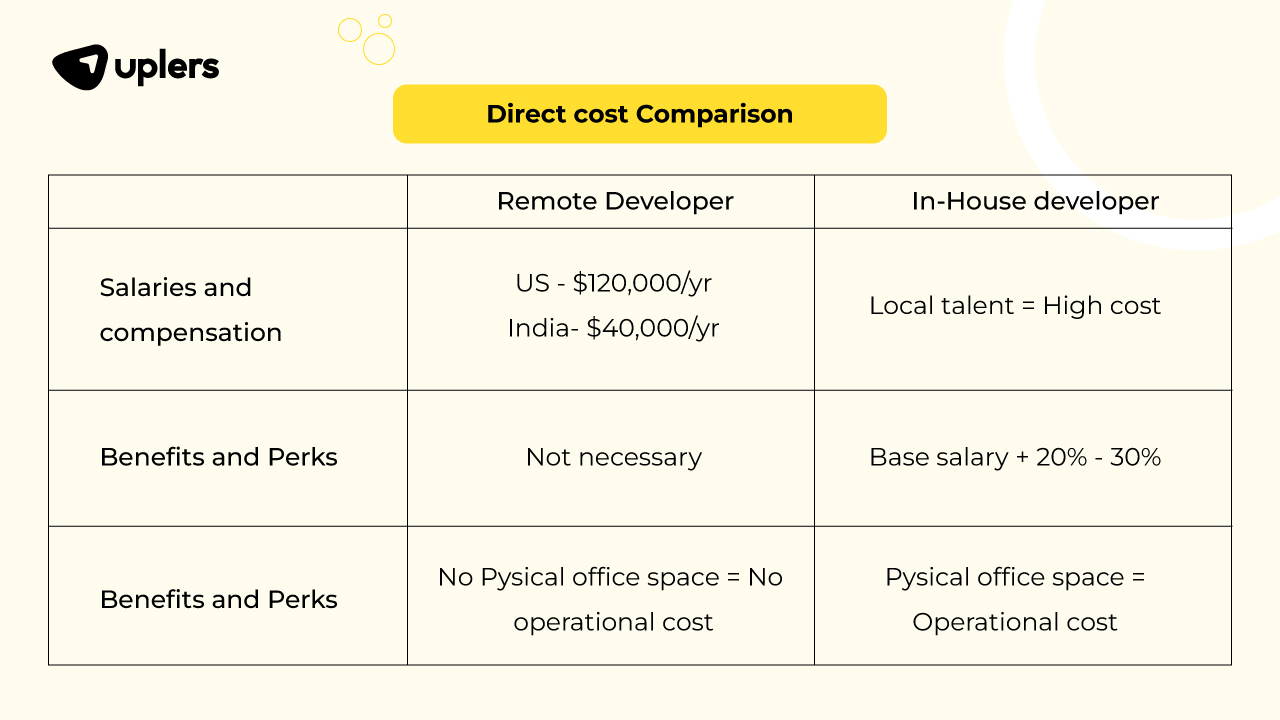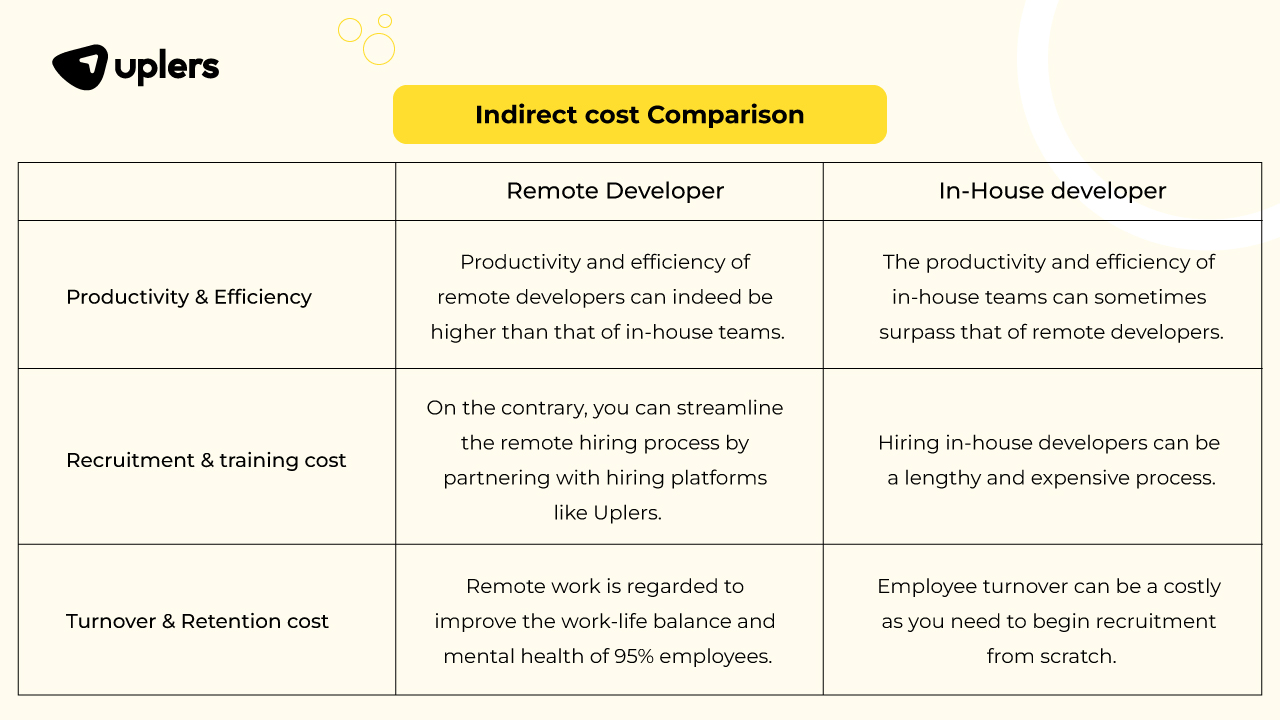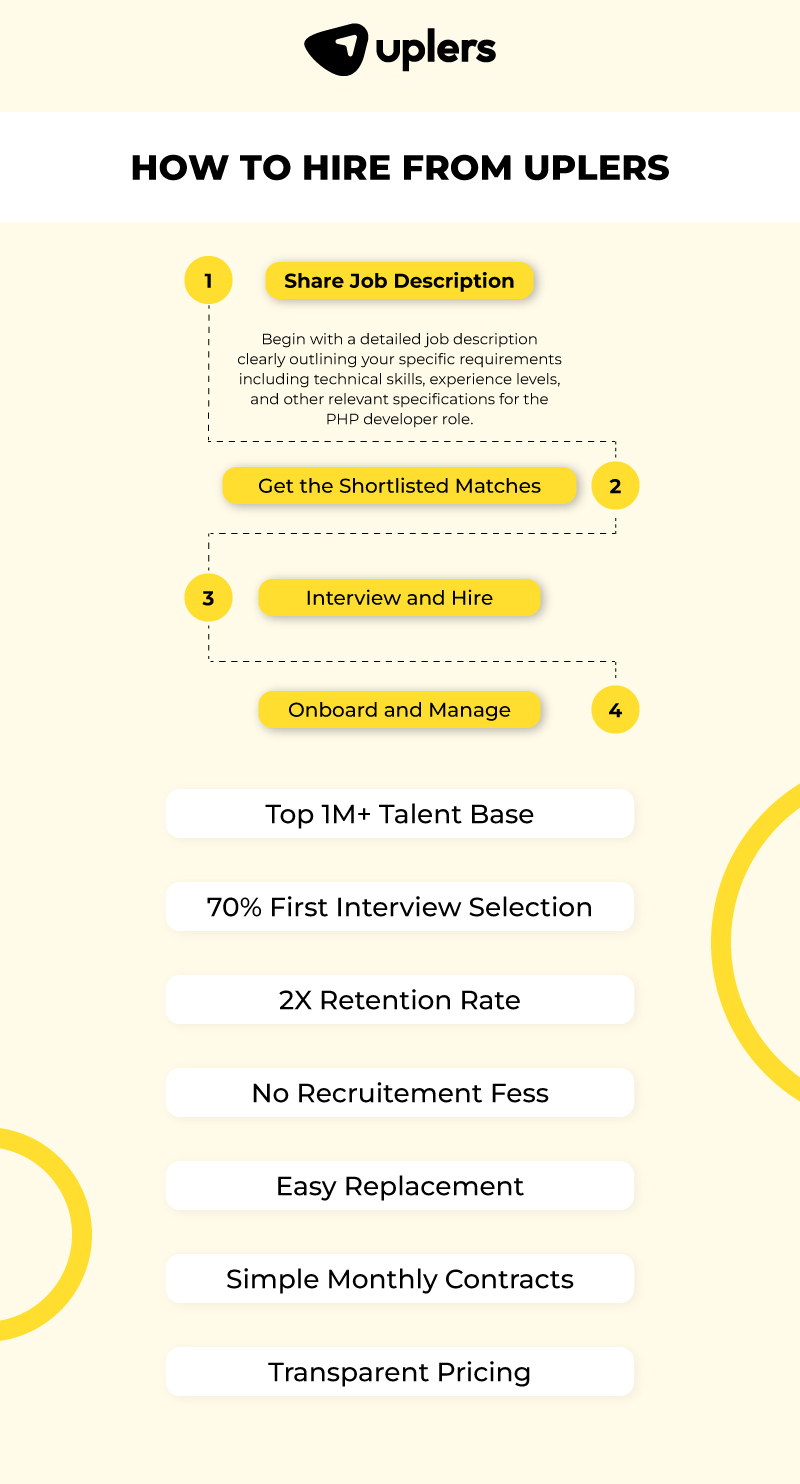Cost Comparison: Remote Developers vs. In-House Developers
- Shachi Dixit
- August 26, 2024
- 7 Minute Read

How many times have you debated in your mind whether to hire remote developers or to hire in-house developers? How many times has your mind backfired on you with a rapid fire of questions such as how to hire remotely, the cost of hiring remote developers, why you should prefer to hire in-house developers, what are the pros and cons of both the choices, and many more
Well, all these are completely normal questions!
Although 1/5th of the global workforce has transitioned to remote work and an estimated 32.6 million Americans will be working remotely by 2025, the acceptance of this work model is a bit difficult to digest. This is a difficult choice mainly due to the financial implications of both these models.
Therefore, in this blog our aim is to educate and help hiring managers like you make an informed decision, by providing an elaborative cost comparison between remote developer vs. in-house developer recruitment approaches.
Understanding Remote Developers
Let’s first begin with an overview of what a remote developer role means and what are the various types of engagement models that you will come across. This understanding is vital when you are considering the cost of hiring remote developers and determining the most cost-effective way to build and manage your team.
Remote developers are professionals who operate from locations outside your geographic proximity and can be located globally. When you choose to hire remotely it means you are willing to surpass the geographical hiring barriers to expand your talent reach. They work outside your typical physical work office either as freelancers, contractors, dedicated remote teams, or even employees of a company operating from a distinct location.
Understanding In-House Developers
In-house developers are the traditionally followed teams that work in your office space across your cubicles. This employment model has been in the hiring landscape from the get-go and includes engagement models such as full-time employees that dedicatedly work with you, part-time employees who work for a few hours, and on-site contractors hired for specific projects.
While the in-house approach fosters greater control and project dynamics, it comes with high overhead costs and little room for flexibility in the evolving marketplace.
Direct Cost Comparison

Now that we have an understanding of both the hiring approaches let’s clear the air with the thought that is clouding your judgement. The ‘cost implication’ of both these hiring options.
Let’s first take a look at the direct comparison of the cost of hiring remote developers vs. in-house developers.
Salaries and compensation
Compensation always gives the go ahead when the job seekers take a first glance at the job description. They consider applying for the job only if the salary appeals to their expectations. Remote developers often present a more cost-effective option because you can hire from regions with low development costs. In case of in-house developers you are restricted to the local talent network which is why it can be costly for you to find a talent with the specific skills and expertise due to limited talent availability.
For instance, hypothetically stating a remote developer in the USA might cost $120,000 annually, whereas in India it can be between $25,000 to $40,000. This difference can highlight the potential cost savings when considering how to hire remote developers.
One effective tool you can use when formulating the compensation strategy is the Uplers salary analysis tool. It will give you real-time salary insights between tech and digital talent of hiring locally versus hiring Indian remote talent. This will help you align your compensation strategy with the industry benchmarks.
Benefits and perks
In-house developers receive comprehensive benefits such as health insurance, retirement plans, paid time off, and several other perks. These benefits will add 20%-30% in the base salary of an in-house talent.
Remote developers on the other hand usually do not receive these benefits. This can be another substantial cost-saving when you choose to hire remote talent.
Overhead costs
This consideration is worth its weight in gold when you are choosing between on-site and remote hiring. In-house developers require office space and this comes with operational and overhead costs such as office space, furniture, utilities, and other infrastructure.
Remote developers on the other hand help you eliminate the cost of maintaining a physical office space. According to Global Workplace Analytics, businesses can actually save up to $11,000 for every employee working remotely 2-3 days per week.
Indirect Cost Comparison

Apart from these direct and obvious cost implications, there are several other indirect costs that are also associated with an informed hiring decision. The top factors in this category include:
Productivity and efficiency
Productivity levels can significantly vary between remote and in-house teams. The productivity and efficiency of remote developers can indeed be higher than that of in-house teams.
A Stanford study revealed a 13% boost in the productivity of remote workers and a McKinsey study reported that 83% of employees believe they can work more efficiently and productively in a remote work setup. This is mainly because they have the flexibility to operate from their convenient location with minimal workplace distraction at their preferred time.
Recruitment and training costs
To hire in-house developers can be a lengthy and expensive process, requiring you to advertise your job on multiple platforms and conduct extensive interviews. Training new developers can further add to the hiring timeline and cost.
On the contrary, you can streamline the remote hiring process by partnering with hiring platforms like Uplers. Their AI-vetting approach can reduce the hiring time and cost which we will discuss in the subsequent section. Additionally, remote developers have experience of working for a global clientele on diverse projects which is why it minimizes the need for extensive training.
Turnover and retention rates
Employee turnover can be a costly affair as you need to begin recruitment from scratch and train the newbies which can result in loss of productivity during the transition period. Remote work is regarded to improve the work-life balance and mental health of 95% employees. This fosters job satisfaction and results in higher employee retention rates as compared to in-house teams.
Hidden Cost Savings
Several hiring factors can offer hidden cost savings when you are analyzing the cost of hiring remote developers vs. in-house developers.
Time zone differences
When you choose to hire remote developers there is an advantage of round-the-clock productivity. The time zone disparities help you leverage the remote teams when the in-house teams are off the clock and this 24*7 operations results in an agile time to market.
Communication and collaboration tools
You must spend on the collaboration tools such as Slack, Zoom, and project management software like Jira. Effective communication is the life and blood of remote teams and any project success. These tools can also prove to be beneficial for in-house and hybrid teams.In the present competitiveness and evolving market, irrespective of having in-house or remote teams you need to be on your toes by investing in these tools for effective project management and collaboration.
Potential legal and compliance costs
If we are being very transparent, yes there are legal and compliance strings attached to remote hiring models. This will add to your hiring cost because you are hiring talent from a different country for your location so you need to be mindful of the laws. These costs can come in the form of differing labor laws, tax implications, and data protection regulations. It can offset the savings made from lower salaries and overheads.
But that doesn’t mean there are no such compliance issues when you hire in-house developers. For in-house teams compliance costs would associate drafting employment contracts, workplace compliance, taxes and benefits, intellectual property protection, etc.
Quality and Performance
Skill levels and expertise
In terms of access to a diversified skill set you must opt to hire remote developers. This is because when you in-house your reach is limited to local talent which is why you can’t access niche skills and expertise.
Whereas, in remote hiring you can gain access to a broader skill set as it opens up access to a global talent network. As a result, you can find highly specialized skills which might otherwise not be available locally at lesser price and deliver high-quality work.
Work quality and innovativeness
In-house developers can have good work quality and innovative ability as you can supervise them directly. Whereas, remote developers have the experience of working for distinct projects across the globe which is why their work quality can be of international standards with the fine touch of innovative and creative solutions.
Scalability and flexibility
The cost of hiring remote developers can also be balanced due to the scalability they offer. You can flexibly scale your team size up or down based on your project requirements when you hire remotely. When you opt for an in-house team you are restricted with a long-term commitment irrespective of the market dynamics and your project demands.
How Hiring Platforms Make Remote Recruitment Effortless?

If you are confident enough to hire remotely but are caught up in the dilemma of how to hire remote developers, several hiring platforms like Toptal, Turing, Uplers, Upwork and many more are there in the market that can ease this for you.
Among the notable hiring platforms in the market, Uplers is reputed for its precise AI-vetting process making remote hiring from India effortless. Uplers has a 1M+ talent network across 5+ time zones helping to bridge the gap between global companies and Indian remote talent. At Uplers, we take pride in our AI-vetting process where we shortlist an ideal match for the job in a 4-step process. You will receive the top 3.5% of AI-vetted profiles in your inbox within 48-72 hours of raising the request. Be rest assured that they are thoroughly vetted by our accurate AI algorithm and human touch.
Apart from this several other USP’s that will make you want to partner with us are:
- Unlike staffing agencies or other hiring platforms our fees aren’t hidden. We follow a transparent pricing model.
- You can save up to 40% on the cost of hiring remote developers.
- There is a 2-week risk-free trial period.
- You can ensure talent suitability with our 30-days talent cancellation policy.
- We are with you even post talent deployment with a lifetime free talent replacement policy.
- No need to worry about the complex hiring regulations as we are your one-stop partner from talent sourcing to onboarding.
Final Thoughts
Therefore, the decision to hire remote developers versus in-house developers involves several cost considerations. The cost of hiring remote developers can be substantially pocket-friendly for your hiring budget and can expand your talent access. Connect with us today and make your remote recruitment effortless with the right talent.









